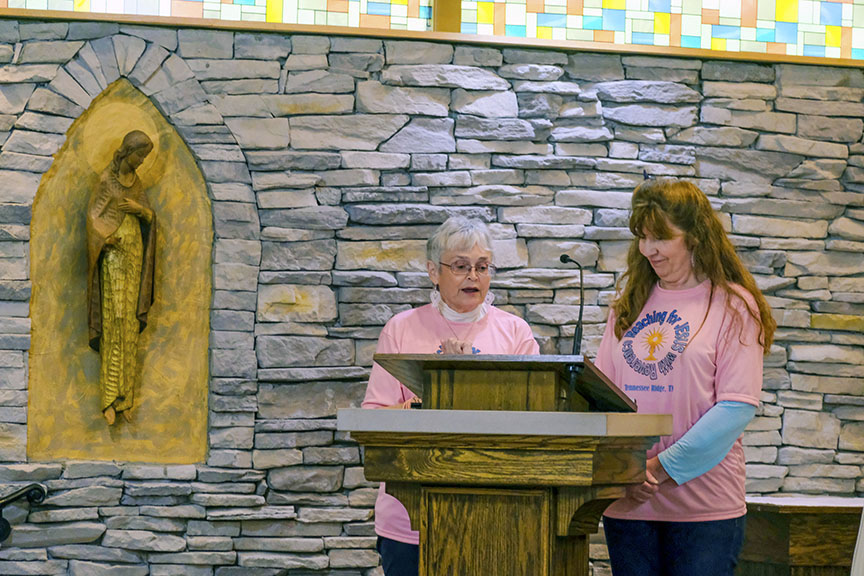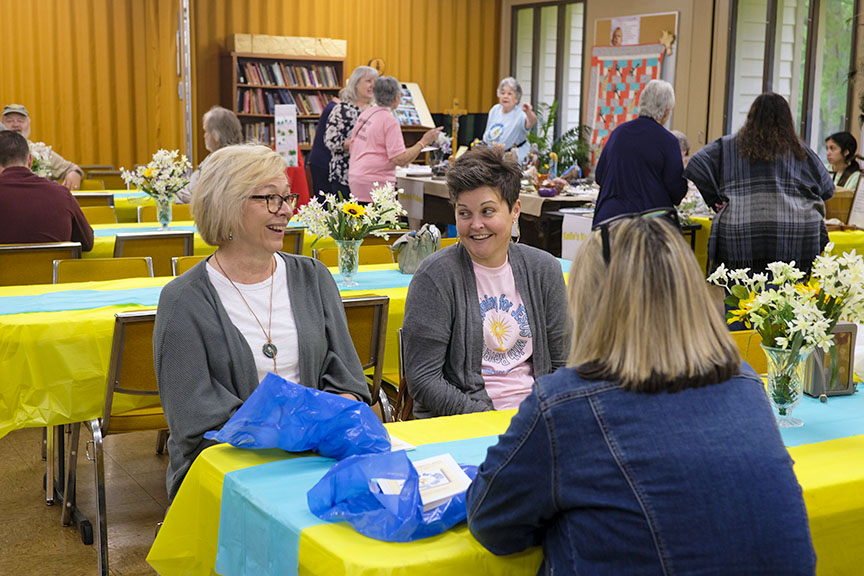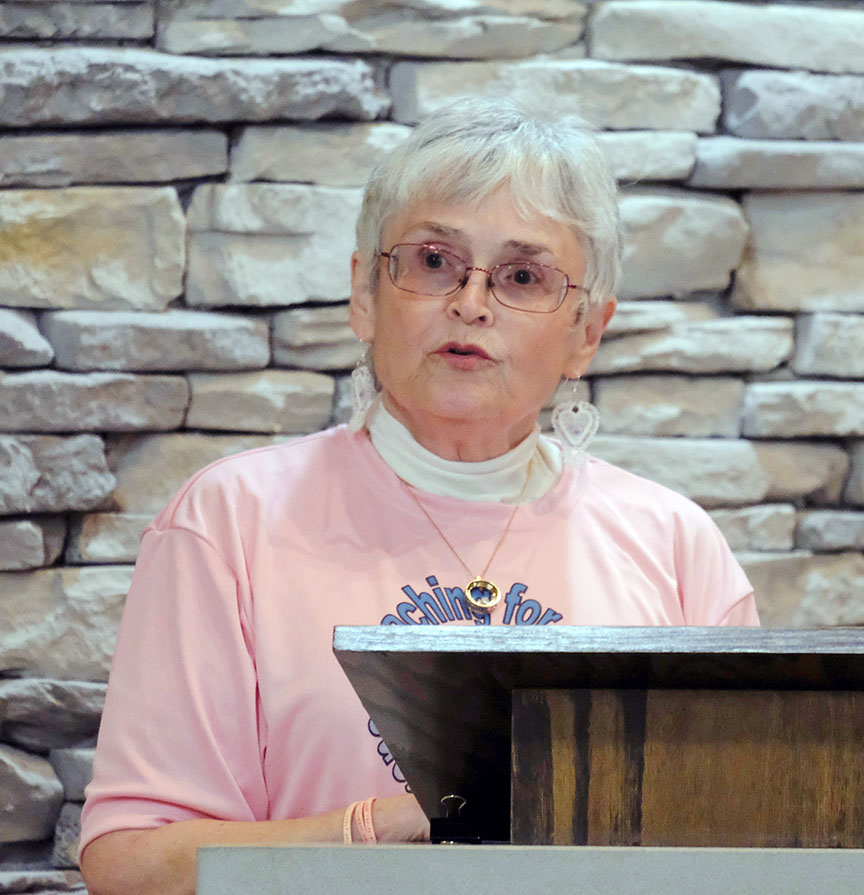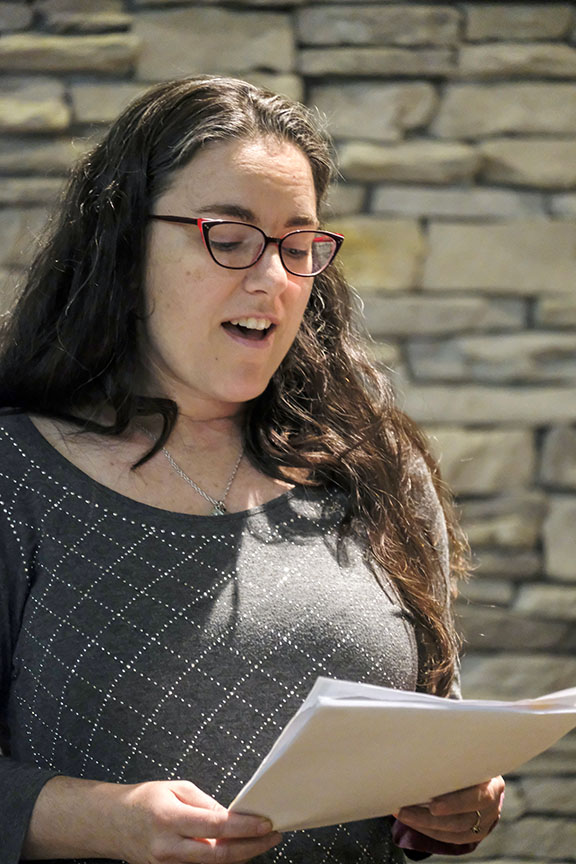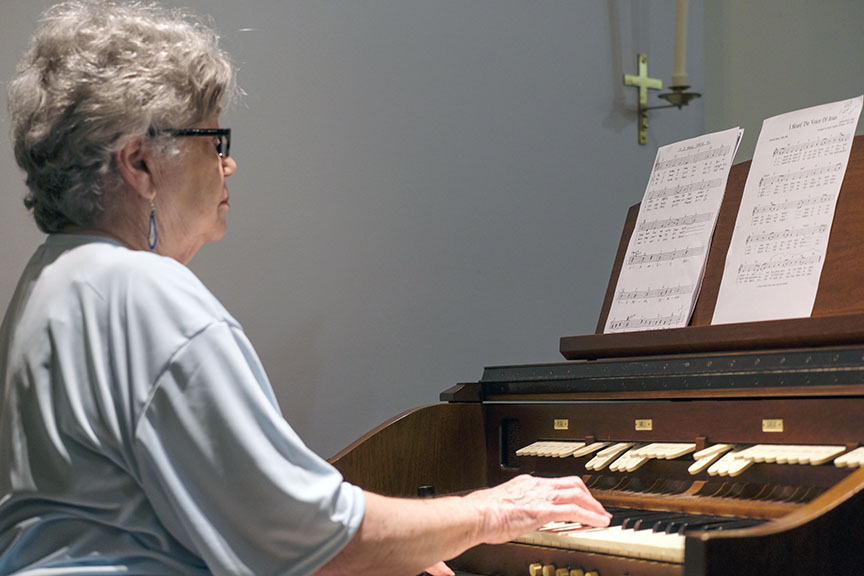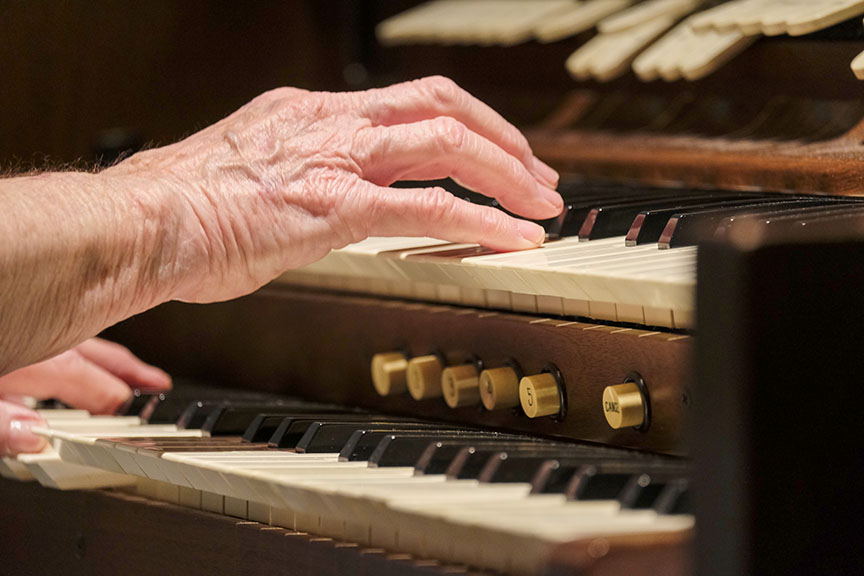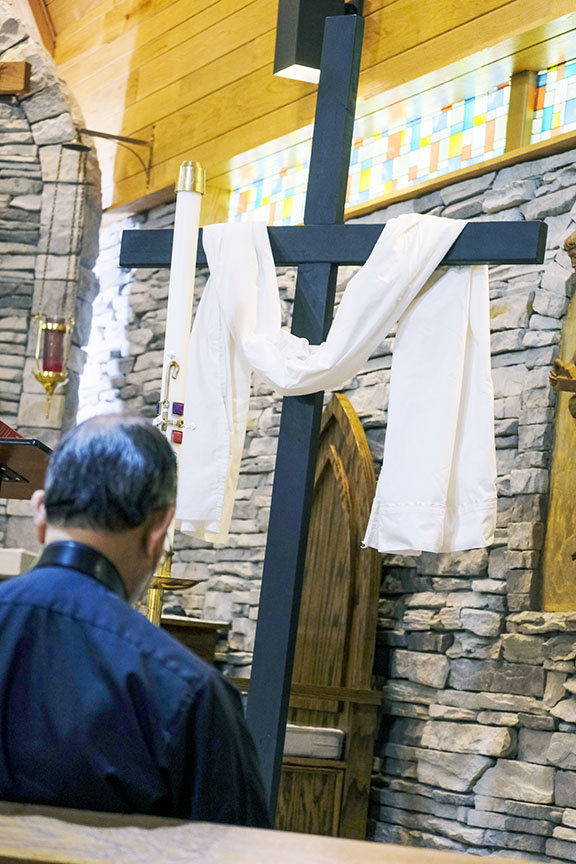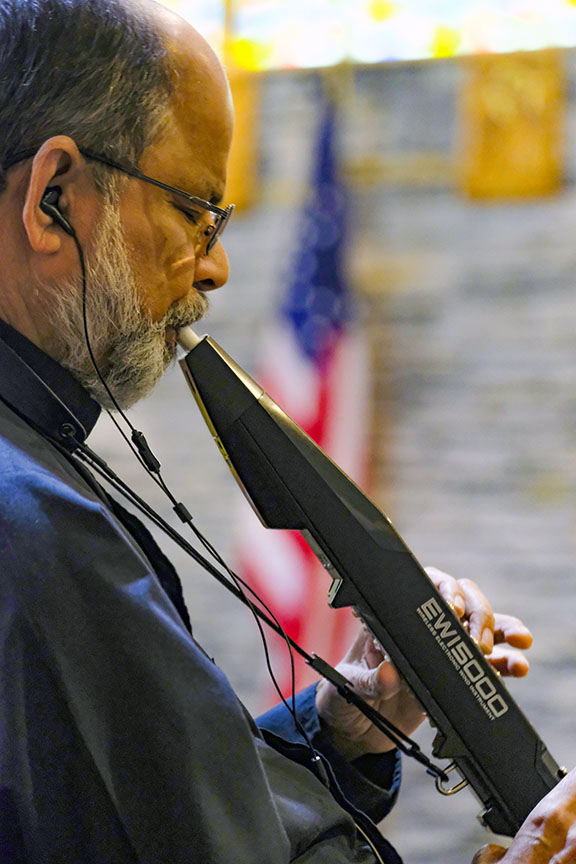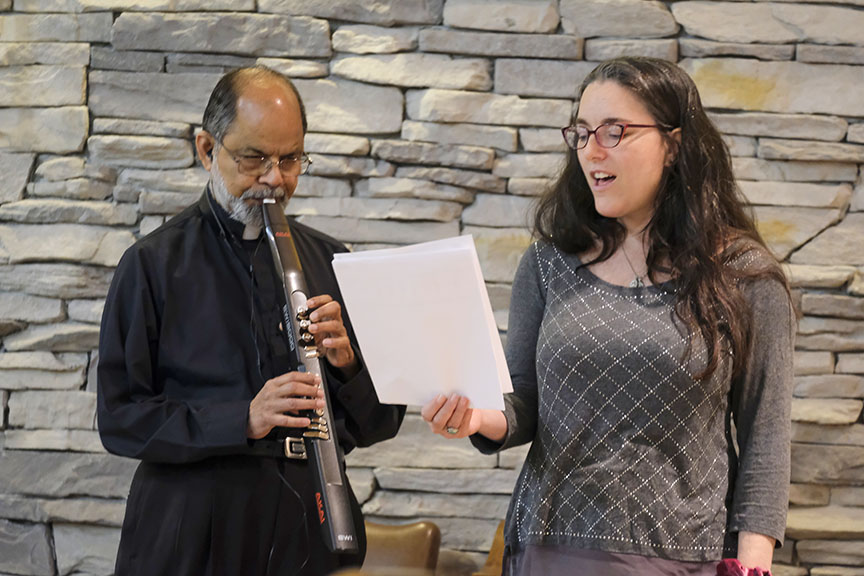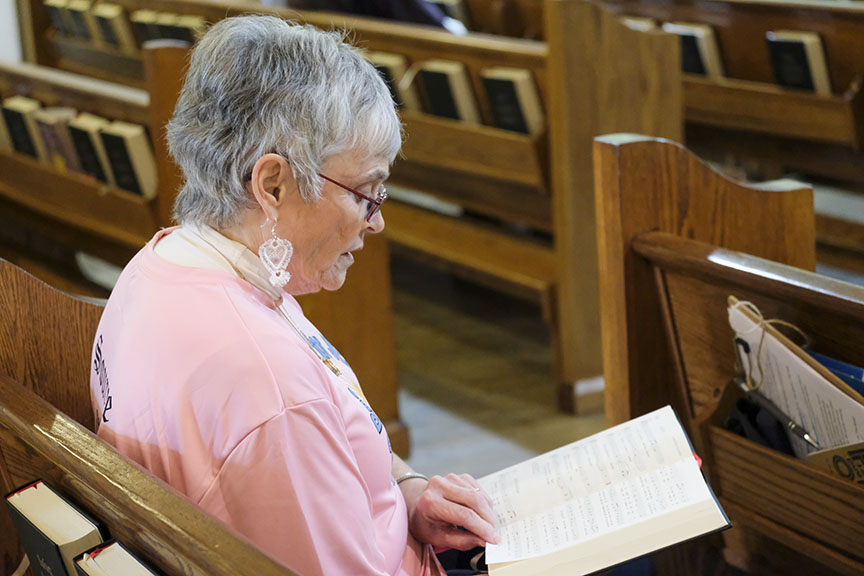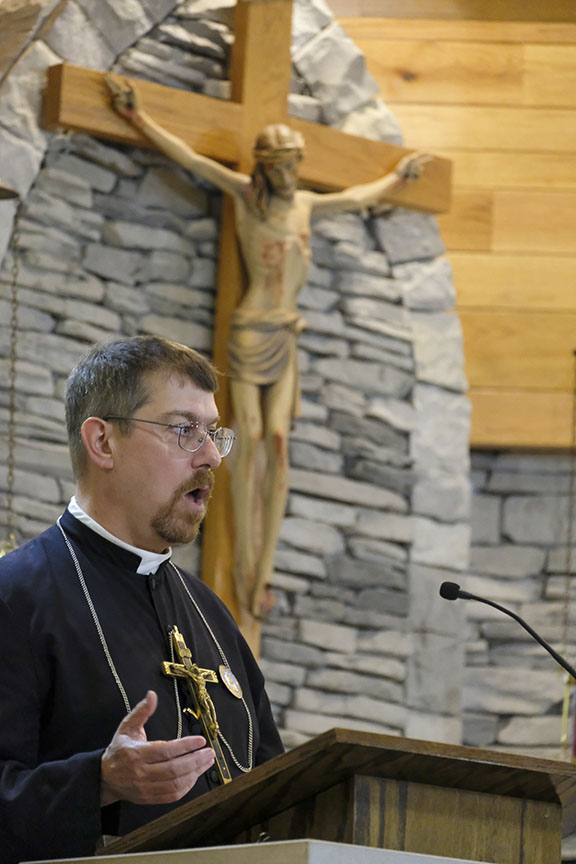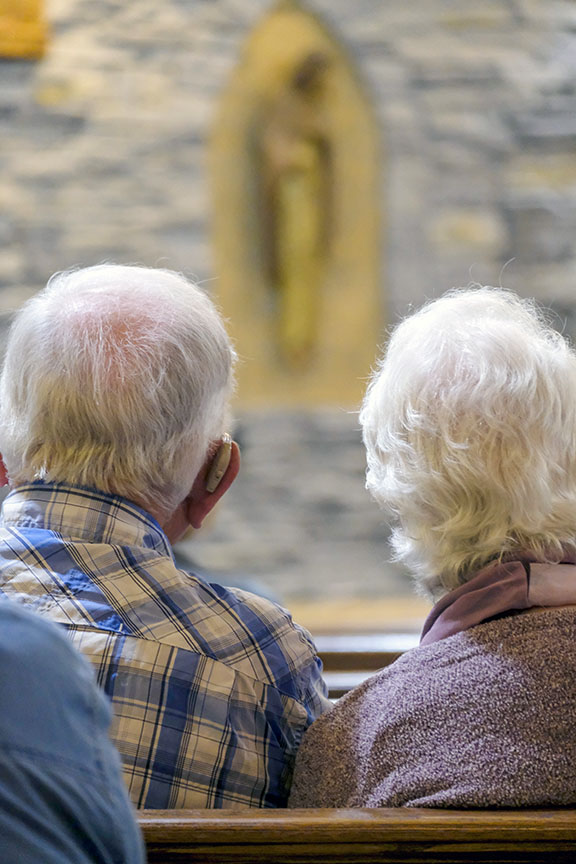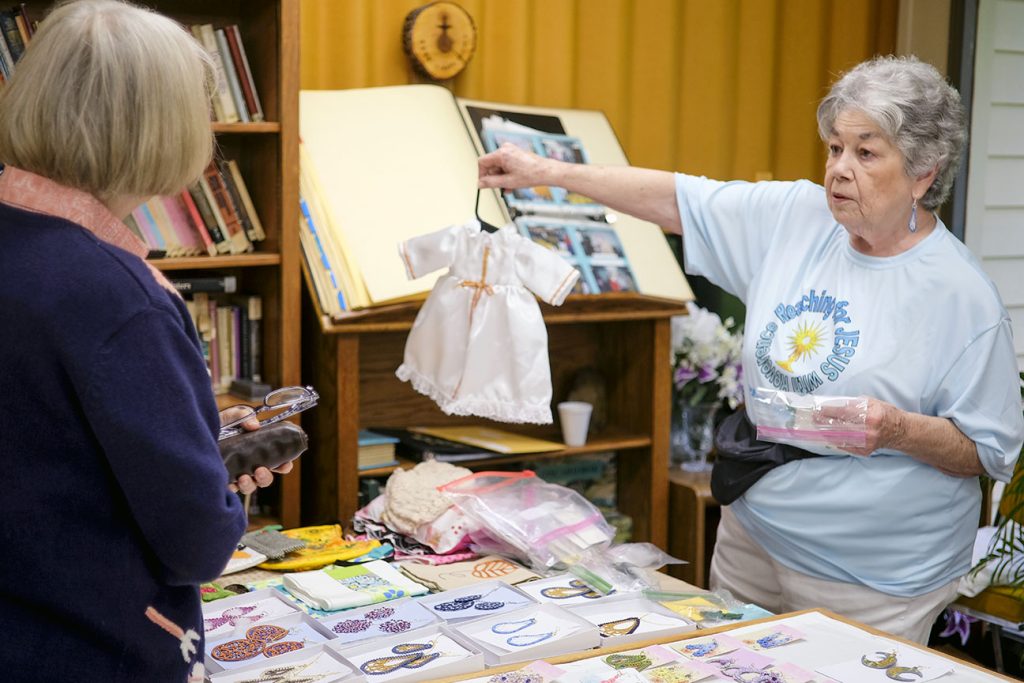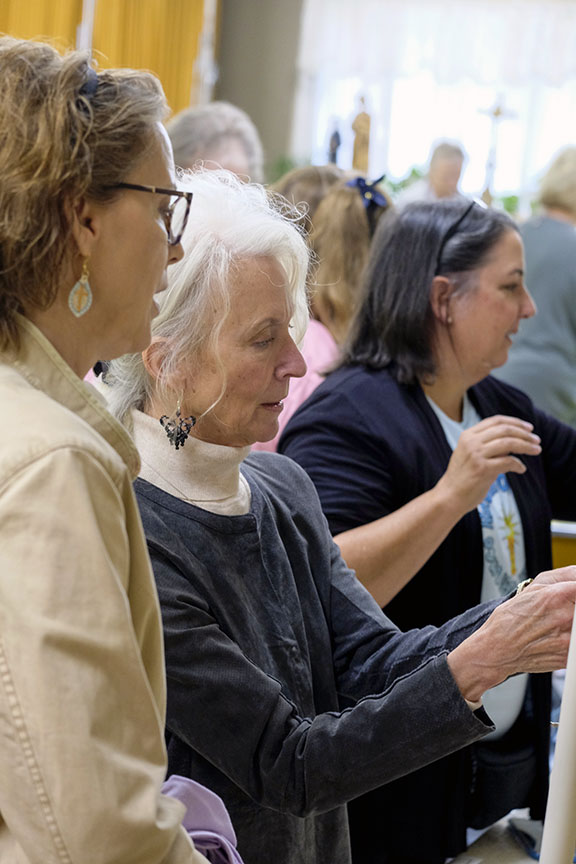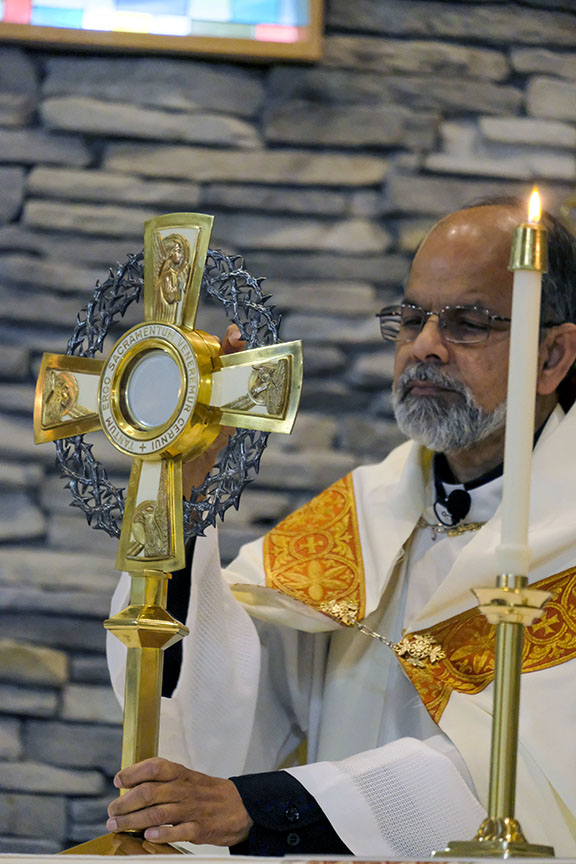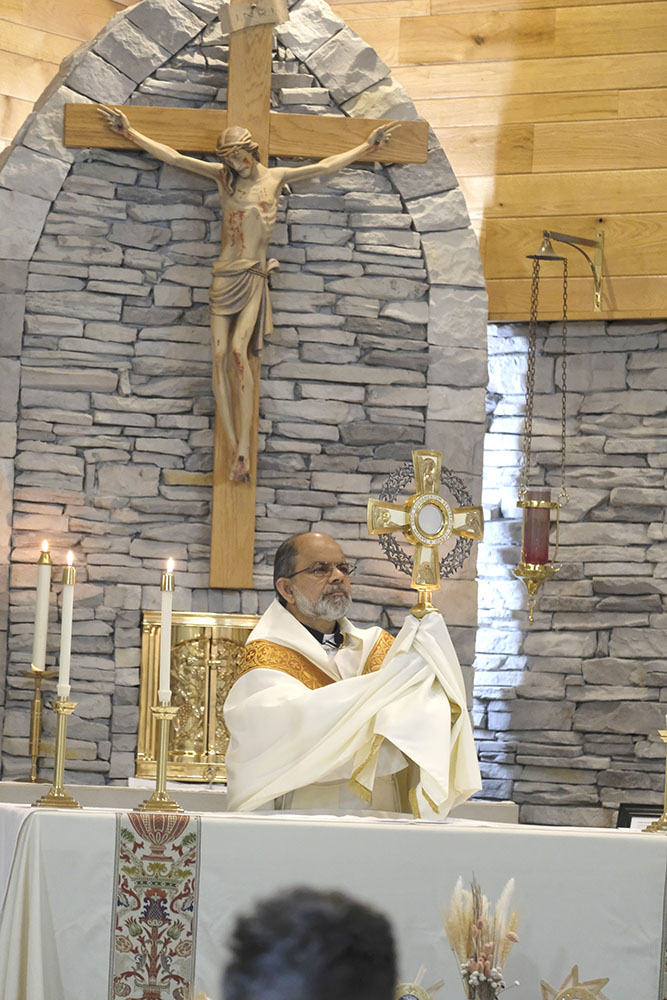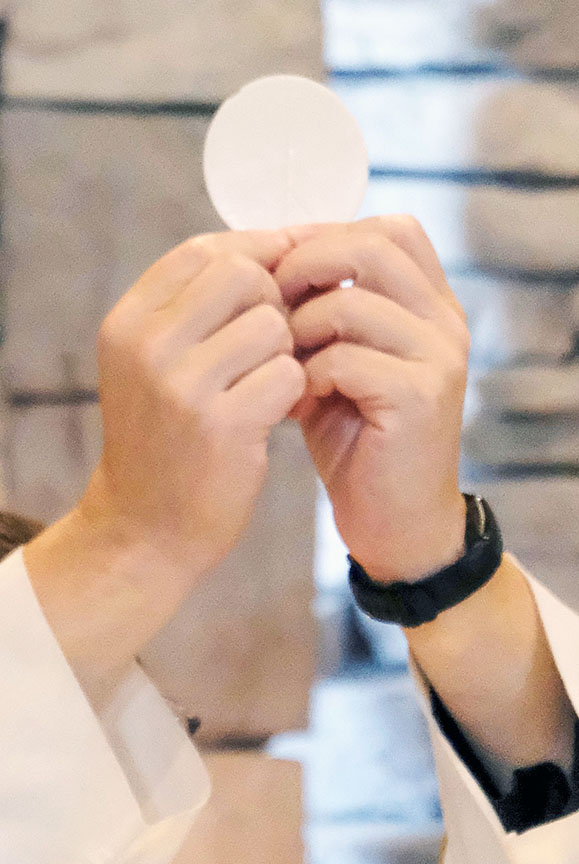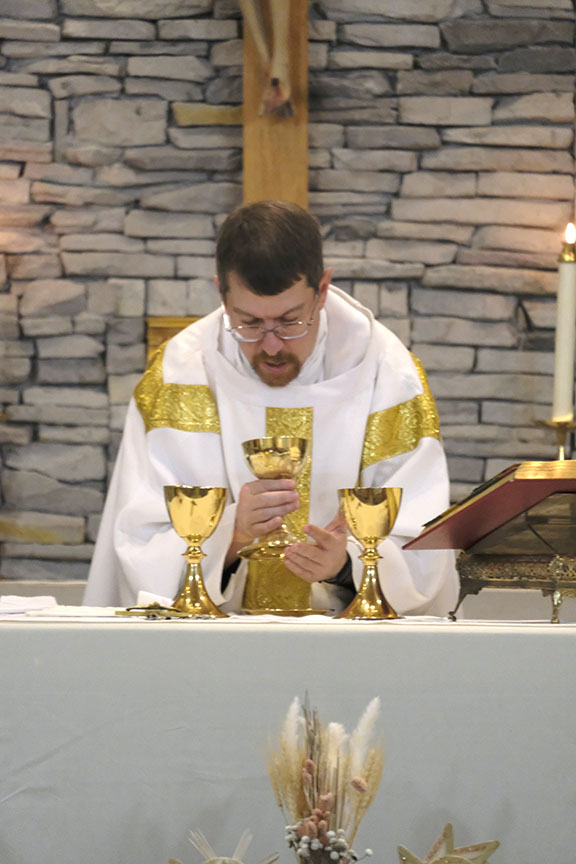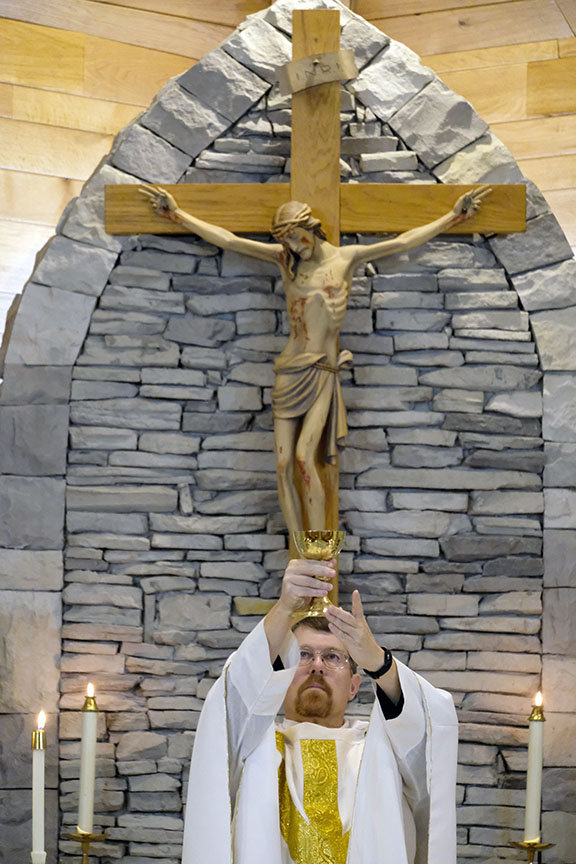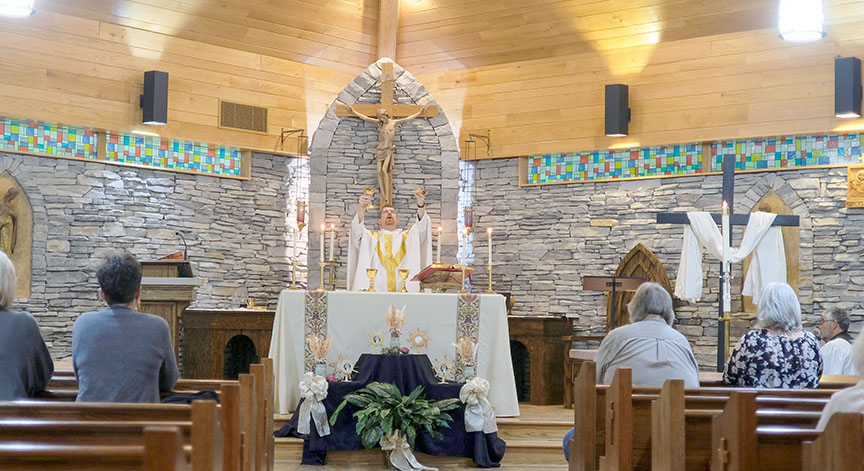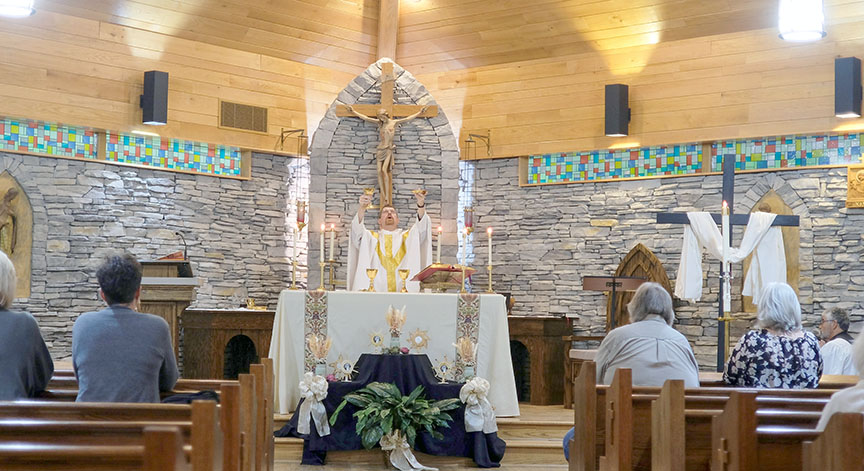
Several Catholics received the reminder to “Look up. This is where the miracle happens,” during the “Eucharistic Congress: Reaching for Jesus with Reverence” on Saturday, April 29, at St. Elizabeth Ann Seton Catholic Church in Tennessee Ridge.
Nearly four dozen Catholics from around the Diocese of Nashville made the trek to the northwest corner of Middle Tennessee to spend a day centered around the real presence of Christ in the Eucharist.
The one-day retreat was organized by Valerie Brown, director of religious education and office manager at St. Elizabeth Ann Seton, and Bonnie Lill, a volunteer in the CCD program.
A few years back, “I had noticed that there was a lack of reverence for the Eucharist, not just at our church, but across the board,” Brown explained.
After speaking with Lill about it, they decided to home in on the Eucharist with their religious education classes first. “Everything we taught went back to the Eucharist,” Brown said. “We started with adoration in the church because we wanted their relationship with God to be strong, not just their knowledge of the Eucharist.”
From there, the efforts continued to the adults with messages in the bulletin and other activities.
Meanwhile, Lill got an idea.
“I had been watching coverage of the 2020 international Eucharistic Congress in Budapest, and I thought, ‘We can do this,’” she explained. “I researched what a Eucharistic Congress was, the rules and guidelines for them, talked to Valerie, and we brought it to the parish council. They said run with it, and we did.”
With the intercession of the Holy Spirit and several saints, the day finally came and both Brown and Lill had high hopes for those who came.
“We just want everyone to have a rekindling of the true presence of Jesus in the Eucharist,” Brown said. “Some of them will be challenged with the talks, but we hope that they hear the Holy Spirit talking to them, and they leave with a new fire for their belief in the Eucharist.”
“We just want people to fall in love with Jesus more and more,” Lill added.
Fulfillment of the Old Testament
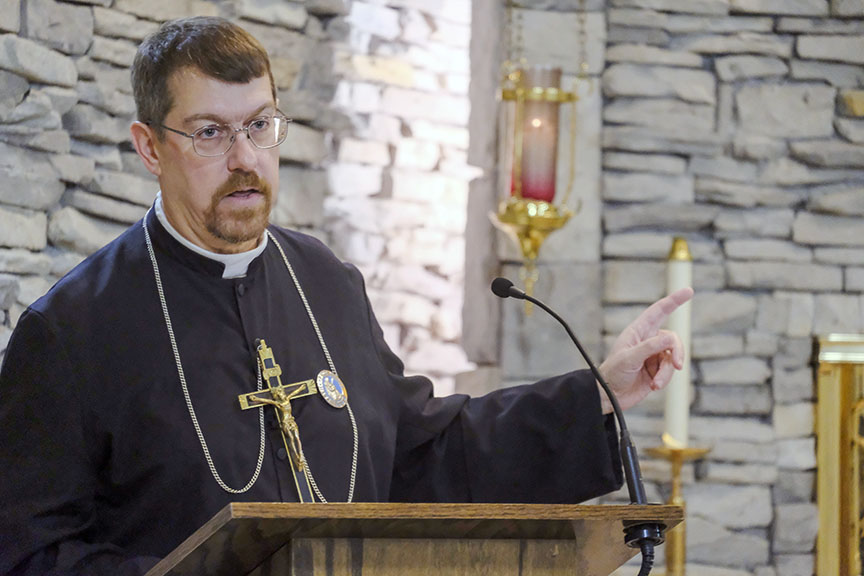
Along with participating in adoration, the sacrament of Reconciliation, and attending Mass, the main portion of the day came from six talks, four of which were given by Father of Mercy Ben Cameron, a parish mission preacher and retreat master, as he talked about “The Holy Eucharist: Shadows and Fulfillment.”
Beginning with the Passover sacrifice, Father Cameron focused on how Jesus is the Passover lamb sacrificed in the book of Exodus. And as God delivered the Israelites out of slavery – “as Catholics, we are the new Israelites” – Jesus delivered us from the slavery of sin and death.
At the Last Supper, Father Cameron continued, Christ uses bread and wine and not a lamb.
“What our Lord has done is shifted the focus of the Passover sacrifice from the sacrifice of the lamb that can only symbolically free one from sin and death to the sacrifice of the Lamb of God who could and did take away sin, the sin of the entire world,” Father Cameron said. “He has shifted the focus of the meal part of the Passover from the eating of the flesh of the lamb to the eating of His flesh that gives true and eternal life.”
“He is the new Passover lamb of the new Exodus,” he continued. “As we celebrate every Mass, the passion and death of the Messiah, He is the new sacrifice of the new and eternal covenant between God and man.
“Jesus commands the apostles to, ‘Do this in remembrance of me,’” Father Cameron said. “In that moment, in those words, He ordained them as the first bishops of the Church to carry on His work, His sacrifice, to make it present.
“We participate in his sacrifice at every Mass, and every Mass the veils of time and space are pulled back,” he said. “We are really present at the eternal sacrifice, the sacrifice that Jesus Christ offered on the cross … and it is made present in our midst.”
“It is a tremendous privilege, an awesome privilege that we have to participate in the holy sacrifice of the Mass,” Father Cameron concluded. “Mass should be the center of our lives, it should be the most important event of our week, and if we can it should be the most important event of our day.”
Father Cameron’s second talk focused on “The Manna: The Holy Eucharist as Communion with God.”
He retold the story of when God sent manna to the Israelites, who wandered in the desert for 40 years, as promised through Moses. Jesus is therefore the new Moses, and His body is the new manna, Father Cameron said. “This is made most paramount in chapter six of John’s Gospel and the Bread of Life Discourse in which Jesus proclaimed, “I am the Bread of Life” given to us in the Eucharist.
“In this passage, our Lord identifies the Holy Eucharist as the new manna. Since the original manna was real and not a symbol, the new manna cannot be a symbol either,” Father Cameron said. “Too many Catholics today act like the Holy Eucharist is a symbol, but it is not. Is there a sign element? Yes. The sign element of eating and drinking. It looks like bread. It looks like wine.
“But the reality is that it is our Lord’s flesh and blood, it is our Lord himself,” he continued.
That’s why a double miracle happens at every Mass. First, the consecration of the bread and wine into the body and blood of Christ, and second, that the body and blood still look and taste like bread and wine.
Father Cameron’s third talk focused on “The Bread of the Presence: The Holy Eucharist as Real Presence.”
Again, Father Cameron referred to the books of Exodus and Leviticus to begin, noting that the worship of the people of Israel centered on the tabernacle just as it does for us as Catholics as it holds the bread of the presence of God.
“The tabernacle is the visible sign of the invisible presence of God,” Father Cameron said.
Jesus speaks about the bread of the presence in chapter 12 of the Gospel of Matthew, when the Pharisees question Jesus as to why He’s allowing His disciples to “harvest” on the Sabbath. Jesus gives a three-fold answer, which refers to the ancient order of priests of the line of Melchizedek.
“This implies that his sacrifice would be that of Melchizedek where there is the offering of bread and wine,” Father Cameron said, which he does at the Last Supper.
“The Last Supper was the institution of the most sacred sacrifice, meal, and presence of God in our midst. It is one in the same the new Passover, the new manna, and the new bread and wine of the presence of God, and through this new bread of the presence, Jesus continues in our midst to this very day and will do so until the end of time,” he continued. “The Holy Eucharist is God’s love for us.”
That’s why the priest holds up the bread and the chalice once it’s been consecrated, to show Jesus to the people.
“A lot of times I look out and what I see people do is they put their heads down, but the whole point of the showing is so you will look. Feast your eyes and heart upon the Lord,” Father Cameron said. “Look, feast your eyes. Adore him by looking at him.
“By our body language, the priest is saying without words, ‘Behold God’s love for you,’” he said. “When we come to adore our Lord in the Eucharist, whether he is exposed in the monstrance, which is a continuation of that showing at Mass, or whether he is hidden in the tabernacle, we are in the presence of God himself, body, blood, soul, and divinity.
“This, my brothers and sisters, is the total fulfillment of that ancient bread of the presence. It is not ordinary bread and wine but the sacred sign and instrument of our Lord’s real presence with us until the end of time. It is the sign of that new and eternal, sealed in the blood of Jesus, the Passover lamb.”
During his final talk, “The Eucharistic Sacrifice: Renewal of the Covenant and Foretaste of Heaven,” Father Cameron talked about the realities of the Mass and what truly happens throughout as it all culminates in the re-presentation of the Last Supper and the sacrifice on Calvary.
“When we come to Mass, we are present at the renewal of Calvary,” he concluded. “It is also the anticipation of heaven.”
The Source and Summit
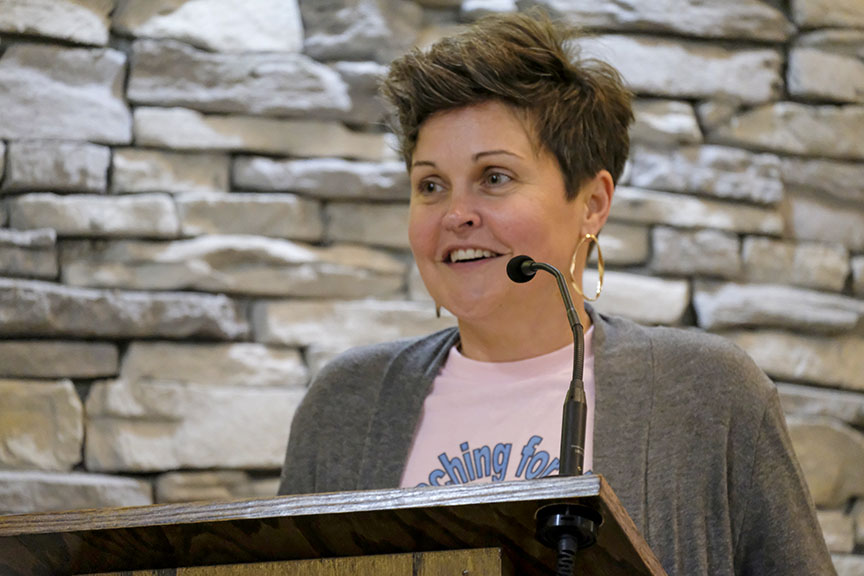
In between Father Cameron’s talks, Kate Morris, a participant of Nashville Cursillo #72, talked about how the Eucharist has been the source and summit of her own personal faith journey and ways she incorporates the Eucharist into the life of her family on a daily basis.
Morris is a member of Sacred Heart Parish in Humboldt and formerly a parishioner at St. Rose of Lima Church in Murfreesboro.
She said it all started at a young age when her mom would tell them, “Look up. This is where the miracle happens,” during the consecration.
Then, she said, she further developed her devotion in adoration throughout different struggles and triumphs in her family life.
“Nothing holds a candle to church,” she said. “Feeling at home in the house of the Lord is a tremendous gift to me.”
Then, noting how the church also starts in the home as Pope Francis often writes, she concluded, saying, “We can have a normal life in the Eucharist.”
Reflections
As the day came to an end participants had several key takeaways from the day.
Matthew Avila, a parishioner of Immaculate Conception Church in Clarksville and a marketing student in his sophomore year at Austin Peay State University in Clarksville, said his key takeaways were the connection to the manna, the importance of the blood of the lamb, and how Jesus’ full body, blood, soul, and divinity are present no matter if one just receives the body, the blood, or both.
“It has been amazing,” Avila said. “I’m so glad God called me to be here.”
Bill and Sue Resler, parishioners of St. Elizabeth Ann Seton, said knowing the retreat was about the Eucharist is all it took for them to attend.
“I believe in the Real Presence,” said Bill Resler, a member of the Knights of Columbus Council 8241 out of St. Christopher Church in Dickson. “I think it’s important to try to convince other people, especially Catholics, of that as well.
“Culturally, we’re moving away from Christianity as a country and as a world,” he said. “We’re going to require a radical cultural revolution to make the presence of Christ real to people.”
Sue Resler said she particularly enjoyed the emphasis on adoration. “It was emphasized that it is supposed to be your quiet time,” she said. “That’s true because it is for me.”
Crystal Miller, a parishioner of St. Francis of Assisi Church in Dover, of which St. Elizabeth Ann Seton Church is a mission parish, said she feels closer to God after the day.
“I have come to a closer connection with God, and how I look at the Eucharist,” Miller said. “I’ve always looked to the Eucharist as the body and blood of Christ, but now I feel like I’m going to have a closer connection to it now after listening to the speakers today.”
Eucharistic Revival
Although it’s been in the works since before the official announcement by the U.S. Conference of Catholic Bishops, this Eucharistic Congress is one of many happenings in the churches throughout the diocese that directly relate to the bishops’ call for a Eucharistic Revival.
The announcement, which came in early 2022, was in response to a 2019 Pew study that revealed that only 30 percent of Catholics believe in the real presence of Christ in the Eucharist. It has led to years of revivals and initiatives in dioceses and parishes across the United States. It will all culminate in the National Eucharistic Congress June 17-21, 2024, in Indianapolis.
As attendees of the conference reflected on that 70 percent who don’t believe in the Real Presence, they had varying thoughts.
“I’d get educated,” Avila said. “But I would also encourage them to ask God Himself through adoration, through receiving him on Sundays. Ask Him, ‘I need answers about this is you,’ and He’ll answer. He’s done it for me.
“If you have a question, go to the main source, which is Him, and I don’t feel like a lot of people do that,” he said. “They try to do their own research and yet are still left without answers, and that’s what prayer is for, to ask Him through adoration, through Mass on Sundays. Just listen. He’ll give you a good answer.”
Miller said that 70 percent should consider coming to a retreat just like this Eucharistic Congress.
“Listen and take the time to invest in the knowledge of God and how He fits into our lives,” Miller said. “He is the reason we’re here, and we really need, as individuals, to take the time to invest in God.
“God has invested everything into us,” she said. “We need to show that we’re just as invested in Him and take the time to get to know Him on a more spiritual level.”
For more information about the Eucharistic Revival, visit eucharisticrevival.org.
